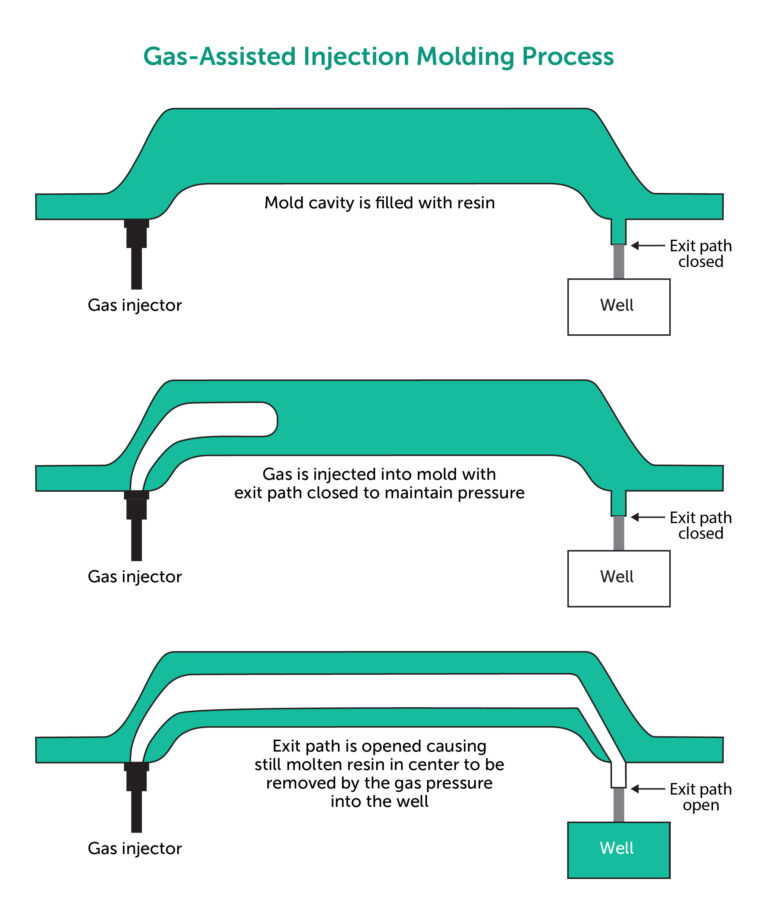Time to read: 7 min
Injection molding defects can reduce the cosmetic appeal and structural integrity of injection molded parts. The causes of these imperfections range from issues with tooling or materials to problems with processing or part design. The solution to a specific defect may require corrective action by the injection molder, the mold maker, or the part designer.
This article describes the top ten types of plastic injection molding defects (listed below) and provides info about their causes and potential solutions
- Flow lines
- Sink marks
- Surface delamination
- Weld lines (knit lines)
- Short shots
- Warping
- Jetting
- Vacuum voids
- Discoloration
- Flash
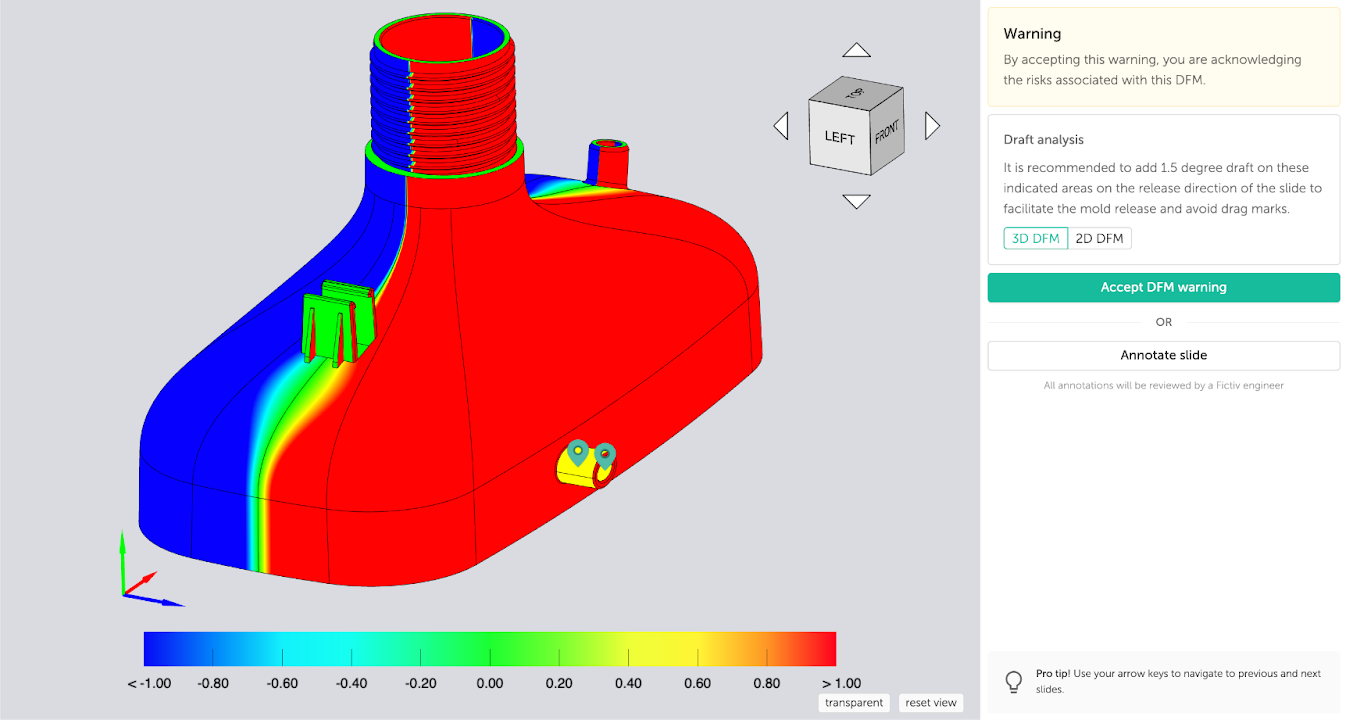
Fictiv provides you with DFM feedback so that you can minimize injection molding defects.
Flow Lines
Flow lines are unwanted streaks, waves, or lines on a part’s surface. When molten plastic moves through an injection mold at different speeds, the resin solidifies at different rates, which causes this type of defect. Flow lines also occur when there are sections of the mold that have different wall thicknesses, or where chamfers or fillets are too small.
Sometimes, an injection molder can eliminate flow lines by increasing the injection speed or pressure of the machine. If differences in wall thickness are the source of the problem, the mold maker may be able to place a gate in a thin-walled section of the mold cavity. Following best practices for wall thickness can help to avoid flow lines in the first place, and our guide can help you design your parts accordingly. Download Fictiv’s Injection Molding Design Guide
Additionally, to help you organize your injection molding projects and plan timelines, download Fictiv’s Free Template: Injection Molding Gantt Chart.
Sink Marks
Sink marks are dents, divots, depressions, or craters on the surface of a part. They appear on a part’s thicker sections, which take longer to cool. When there are significant differences in thickness within a part, the thinner areas cool and contract more quickly. With sink marks, the outer skin on a thick section cools first and is pulled inward by the slower cooling of the thick material that’s beneath the part’s skin.
Injection molders can minimize sink marks by lowering mold temperatures, increasing holding pressures, or prolonging the hold time to allow for greater cooling. Part designers also have a role to play because most sink marks occur where ribs or bosses intersect with the nominal wall. By following Fictiv’s design for manufacturing (DFM) guidelines, you can avoid sink marks.
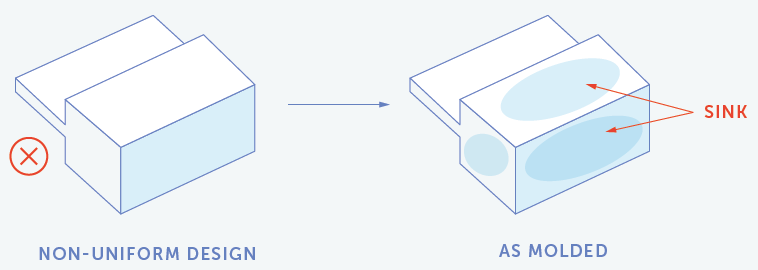
Surface Delamination
Surface delamination is an injection molding defect that causes a part’s surface to separate into thin layers that can be peeled away. It’s usually caused by the presence of contaminants such as mold release agents in the injection molding material. These contaminants create localized areas that prevent the plastic from bonding properly. The effects are more than just cosmetic because they also reduce part strength.
Injection molders can minimize surface delamination by reducing their dependence on mold release agents, typically by improving the part ejection mechanism. Pre-drying the plastic material before molding and increasing the mold temperature can also help. Mold makers can also smooth corners within the mold to avoid sudden changes in melt flow.
Weld Lines (Knit Lines)
Weld lines, or knit lines, occur when two flows of molten resin meet, typically after moving past a hole. They are caused by differences in temperature between the two flow fronts. The result is partial solidification and inadequate bonding. Weld lines create visible marks, but this type of injection molding defect can also reduce a part’s strength and durability.
To prevent knit lines, injection molders can increase the temperature of the molten resin to prevent solidification from starting too soon, and increasing injection speeds and pressure are also potential solutions. Part designers can select resins with lower viscosity and lower melting points, and mold makers can remove partitions within the tool that produce separate flows.
Short Shots
Short shots happen when molten resin doesn’t fill the mold cavity completely. As a result, the parts are incomplete and unusable. Short shots are caused by flow restrictions within the mold, often due to injection molding gates that are too narrow. Insufficient injection pressure and trapped air pockets are also potential causes, and material viscosity and mold temperature can be contributing factors as well.
Injection molders can reduce short shots by increasing mold temperature or resin temperature, or through faster mold filling. Alternatively, mold makers can incorporate additional vents into an injection mold so that more air can escape. If a part design requires a thin section in the part’s interior, placing the gate within the thin section can help.
Warping
Warping refers to bending or twisting that occurs when there is uneven internal shrinkage during cooling. For example, a box-like part that should have straight walls may end up with inward-curving walls instead. When regions of an injection molded part cool at different rates, the internal stresses that result can deform the structure. Often, this occurs when a thin wall is followed by a significantly thicker section.
Part designers can reduce the risk of warping by following best practices for injection molding wall thickness. Semi-crystalline materials are more likely to warp, so material selection can also play a role. For injection molders, it’s important to provide enough time for parts to cool — and at a sufficiently gradual rate.
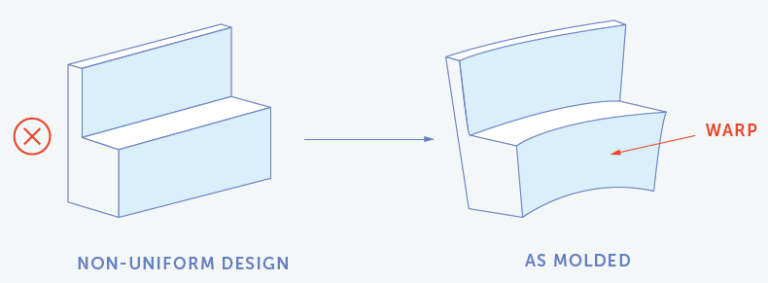
Jetting
Jetting is an injection molding defect that happens when a jet of resin enters the mold too quickly and begins to cool before the entire cavity is filled. The melted polymer sprays into the cavity with a snake-like motion but without first contacting the mold wall. Cosmetically, jetting produces thin, squiggly lines or wavy folds on a part’s surface. Structurally, jetting can reduce a part’s strength.
Injection molders can reduce jetting through temperature adjustments or more gradual fills. Mold makers can also increase the size of the gate to help slow the speed of the jet. Optimizing the gate’s design can also ensure greater contact between the molten plastic and the mold. For part designers, choosing a lower-viscosity plastic can help to avoid jetting.
Pro-Tip: Counter to conventional engineering wisdom, injection molding is actually a great solution for prototyping. Learn how to get higher quality injection molded parts, faster with this webinar “Injection Molding: A Solution for More Than Just Production”.
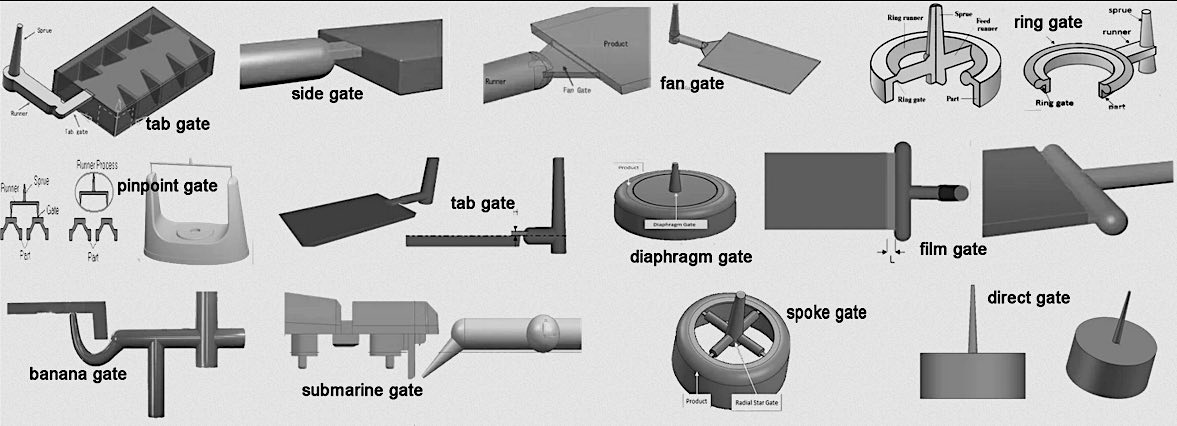
Mold makers can reduce jetting by optimizing gate design. Image credit: plasticmoulds.net
Vacuum Voids
Vacuum voids are pockets of air that are trapped within or close to the surface of an injection molded plastic part. They typically occur when solidification between the surface of the part and its inner sections is uneven. In general, voids occur for similar reasons to sink marks. Rather than pulling in from the outside wall to form a dimple, however, voids open up inside to form a bubble.
Injection molders can reduce vacuum voids by increasing the holding pressure and the hold time. They can also reduce vacuum voids by locating the gate near the thickest section of the part. Part designers can choose a less viscous plastic that allows air to escape from the mold more quickly.
Pro-Tip: If you are looking for our best strategies to employ when designing your injection mold, check out this article “Our Best Tips for Designing Your Inejction Mold”.
Discoloration
Part discoloration can be caused by issues with injection molding machinery, problems with tooling, incorrect process parameters, or poor-quality injection molding materials. For example, machines that are not thoroughly cleaned may contain residues from leftover plastics with a different color. Temperatures that are too high or too low can also cause brown or black marks on the surfaces of parts. Check out this Fictiv article for more tips on how to avoid injection molding discoloration.
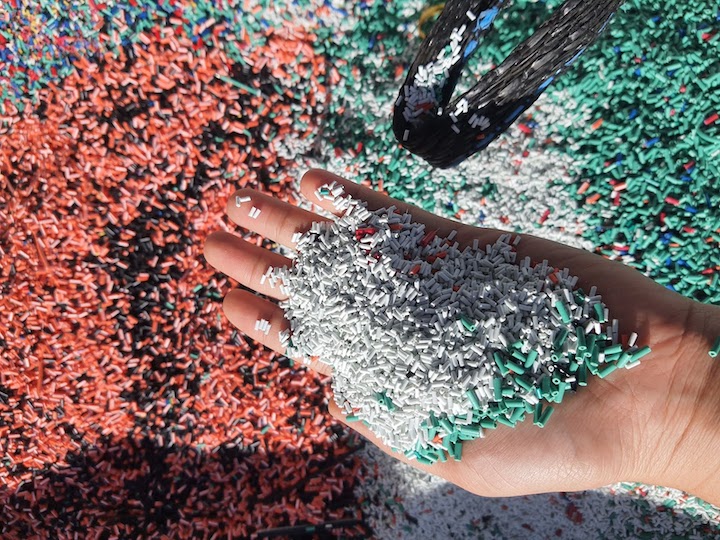
Residues from previously used plastics can cause discoloration.
In terms of tooling, inadequate venting or gates that are too small can cause burn marks as well. Injection molding materials that have too much moisture, or that contain degraded coloring agents or additives, can also cause part discoloration. In general, parts that appear discolored require solutions from the molder or the mold maker rather than the part designer.
Flash
Flash, or flashing, is excess plastic that forms on the surface of injection molded parts. Typically, this unwanted material is forced out of the mold cavity at the parting line; however, flash can also emerge from other locations. Some amount of flash is considered to be a normal part of the injection molding process, but too much flash can mar the surface finish of parts or interfere with their assembly.
The causes of flash include parting line mismatches, improper venting, low clamping pressure, and low viscosity or uneven flow. Mold cavities that are worn won’t fit tightly together, and vents that aren’t deep enough may allow stiffer plastics to protrude. In addition to refurbishing tooling, flashing solutions include increasing the clamping pressure or reducing melt temperatures.
Check out this article “Product Study: Reducing Injection Molding Flash Through Better Part Design” or this one,”Tips to Avoid or Reduce Flash with Injection Molded Parts,” for more tips on reducing flash.
Eliminate Injection Molding Defects with DFM Expertise
There’s a lot that can go wrong during part design, mold making, or the injection molding process itself. To avoid the injection molding defects, you need DFM expertise and guidance that does more than just tell you what can or can’t technically be made. With Fictiv, you’ll get recommended part design solutions and insights that help you avoid problems before they start.
To see our DFM feedback in action and learn how to review DFM feedback, check out this page. Plus, you gain access to our global network of manufacturing partners, all of whom are carefully vetted and are among the most skilled injection molders in the world.Are you ready to learn more? Head on to our injection molding page, or Create your free Fictiv account and get an injection molding quote today.










